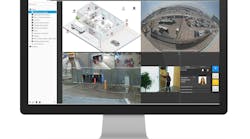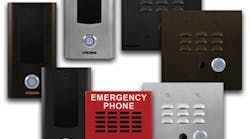Multiple-tenant housing is increasing in popularity, particularly while we're between one of the numerous single-family housing bubbles that we've experienced over the past 40 years. In 2017, for example, there were 358,000 completed multiple-family dwellings, of which 52 percent, or 187,000, contained 50 units or more. Compare this with a decade earlier when there were 284,000 completed, with only 33 percent, or 95,000, having 50 units or more.
It stands to reason that the majority of these 50-unit-or-more facilities likely are located in highly populated locations, such as urban centers or their outlying areas. These facilities must be secured in a manner that assures the safety of those who live, work and visit there.
The security of any multifamily apartment building relies on four layers of protection:
- The physical space surrounding the structure.
- The construction of the building’s perimeter components.
- A quality closed-circuit TV (CCTV) system.
- Reliable locks on all apartment unit doors.
In this article, we’ll discuss all four elements with respect to large multiple-tenant buildings and look at ways in which you, the security professional, might approach an assessment of such a facility along with the necessary points of protection.
No. 1: Protect the Property Line
The first and outermost layer of protection includes sensible landscaping, well-placed outdoor lighting, automatic electric/hydraulic entry/exit gates and a quality CCTV system. All of these help to assure that only authorized people can access the apartment building’s parking areas.
Gates also reduce the likelihood of a personal attack against residents, visitors and employees, because criminals don’t have ready access to the property, and it ensures that a criminal can’t sit in wait innocuously in the safety of their motor vehicle. Standing in a parking lot without a motor vehicle makes it more difficult for a criminal to escape the observant eye of those who might be watching.
“Automatic gates give the property owners the ability to control vehicles through one or several choke points,” says Michael Brooks, master instructor with The Access Control Expert School of Dallas. “When combined with perimeter fencing and pedestrian gates, you have more control over who and where people access the property. This allows you to concentrate video surveillance, on-site security and monitoring at these choke points, lowering the construction costs and possibly allowing the budget to provide specialized surveillance equipment, such as license-plate recognition cameras.”
An intercom/video intercom system can be employed at the “In” gate when visitors are expected to park within the confines of the complex, typically in a designated visitors area. Inside each apartment unit, a wall-mounted suite station allows the tenant to speak with and view the person seeking to enter the facility. The gate can be activated by pressing a release button on the suite station.
Some apartment intercom systems use the tenant’s mobile device. The centralized control system inside each low- or high-rise apartment also might be equipped with a landline phone feature, where a single telephone jack using CAT-5e or 6 cable can be installed in each unit. In the event that a tenant doesn’t have a cellphone, they can purchase a landline telephone or obtain one from the apartment manager, sometimes at a minimal monthly cost.
In many complexes, tenants are issued a fob or card for opening the gate. That same credential can be used to control access to common areas, such as laundry rooms, business centers, gyms, pools and tennis courts.
No. 2: Protect the Building
The second layer is construction-related, such as the type and quality (strength) of all perimeter doors, windows and door locks. Whether these locks are controlled with a key or by electronic means, or both, the mechanical portion must be capable of withstanding an attack. This is why these locks should be rated Grade 1 commercial by the Building Hardware Manufacturers Association. In fact, a combination of Grade 1 locks and some form of electronic access control (EAC) is almost a necessity, in addition to an intercom systems.
“In an apartment building, there are always going to be tenants that constantly move in and out,” says Matt Welty, general manager at Codelocks. “There will also be employees who come and employees who go. Therefore, it is important to utilize an access control or lock product that will facilitate easy changes in order to maintain proper access control of the facility.”
For tenant convenience, mechanical locks can be equipped with electronic, wireless cylinder plugs that provide rapid, easy access by way of a mechanical key. The wireless portion of the equation involves sending user data to a central controller that will store it for future use. This data will include the user name, date of each use and the time.
According to Welty, this “allows any employee to use a control key to change the keying on any door, with no technical knowledge required. Many new smart locks combine the ease of making changes with the additional feature to capture audit-trail information, as well as provide time functionality to the locks if desired.”
In other words, it’s possible to program the operation of such a lock according to the day and time. Perhaps, for whatever reason, an apartment manager would like the facility to unlock each day at 8 a.m. and lock at 8 p.m. This is a popular feature when businesses are present on the first floor or when offices are in the building. This type of lock will accommodate such a requirement.
Traditional access control also can be used with ordinary masterkeyed mechanical locks. This can be an ordinary locking system equipped with a keypad or a high-tech card access system comprised of iClass smart cards and readers.
“HID smart cards and readers provide an elevated level of security from the standard proximity technology that was replaced,” says R. Scott Kern, managing partner with the Kern Group. The use of smart cards position the apartment for the future through biometric authentication at the doors to a secure computer logon and beyond.
In addition, Kern points out that faculty and staff smart cards work as an access credential and a photo ID badge for increased employee verification and security. “It’s crucial that employees and first responders can distinguish immediately who belongs and who doesn’t” through the use of wearable photo IDs, he says
No. 3: Video Surveillance
Layer three involves the use of video cameras on the outside as well as inside. Cameras on the outside of the building are there to record an incident if one occurs. Documenting the who, what, where, when and how of a criminal event is front and center to the mission of any camera system.
Whether it’s an attack against a tenant, guest(s) or someone’s property, the object is to provide a quality high-resolution image or video clip of the criminal. Not only is the intent to allow for restitution, but also to provide justice in the hope that the same crime won’t happen again.
Outdoor cameras have to be contained in IP66-rated weatherproof housings, such as the Bosch Flexidome 5000. This particular camera uses network technology as opposed to older analog components. Outdoor models typically cost more than do indoor cameras, depending on what you intend to install.
Video cameras also boost security in the hallways and all common areas of the facility. Common areas typically include a gym, a swimming pool, a laundry area, elevators, stairwells, a storage area and sometimes an underground parking garage, as often is the case with larger apartment buildings.
As with outdoor cameras, the purpose of indoor cameras is to document events that occur, such as falls and crimes. These events are captured and saved to a hard drive or a remote cloud-based video storage service. Network-oriented camera systems are more versatile and flexible in practice than are older analog systems. For smaller apartment buildings, however, analog systems often will do fine.
No. 4: Reliable Locks
Layer four pertains to the locking systems employed inside an apartment building. Relatively small apartment buildings are known for buying and stocking a common brand or model of mechanical lockset and deadbolt lock in some quantity. In most cases, these locks can be Grade 2 or 3 residential. If the surrounding area is rife with crime, however, consider Grade 1 commercial.
Another option is EAC, however. “The time and energy it takes to change out locksets and deadbolts is probably comparable to someone issuing access cards,” says Mark Selent, locksmith and security integrator with Lock Alchemy of Cleveland.
Selent says someone has to sit at a computer and program access cards for new renters as well as accept used cards when someone moves out. Although some apartment managers might reissue cards to new tenants, Selent says he doubts that many actually do.
“I really don’t think that anyone wants a dirty, used card,” he says. “Each card costs $5 to $10, and that’s why a lot of maintenance guys have a key duplicator with key blanks. They take out the key from a new lock, make new ones, and if they’re smart, they’ll put the originals away for safe keeping.”
Some managers ask for a deposit to cover the cost of the cards when EAC is employed. Because it takes about as much time to program EAC cards as it does to duplicate keys and switch locks, it makes sense to consider EAC. This is true particularly in facilities that contain at least 20 units.
Of course, you have to follow suit with whatever EAC system that’s in use at lobby entrances and other inside common areas. If mechanical locks that have interchangeable cores are in use already, then you should encourage management or owners to install similar locks on apartment doors. This will make the job of rekeying relatively fast and inexpensive in the long run, particularly if the plugs are of the wireless variety.
In conclusion, the task of sizing up an apartment complex requires experience in all of the various security disciplines. Knowledge typically comes through experience, and experience comes by doing. One option is to work with an individual who has worked for a sizable security company. Have your most promising lock technician shadow that person on apartment jobs, so your tech logs on-the-job time doing that what you aim to provide to your apartment clients.
Allan B. Colombo is a longtime trade journalist and professional in the security and life-safety markets. You can contact him at [email protected], 330-956-9003 or www.tpromocom.com.





